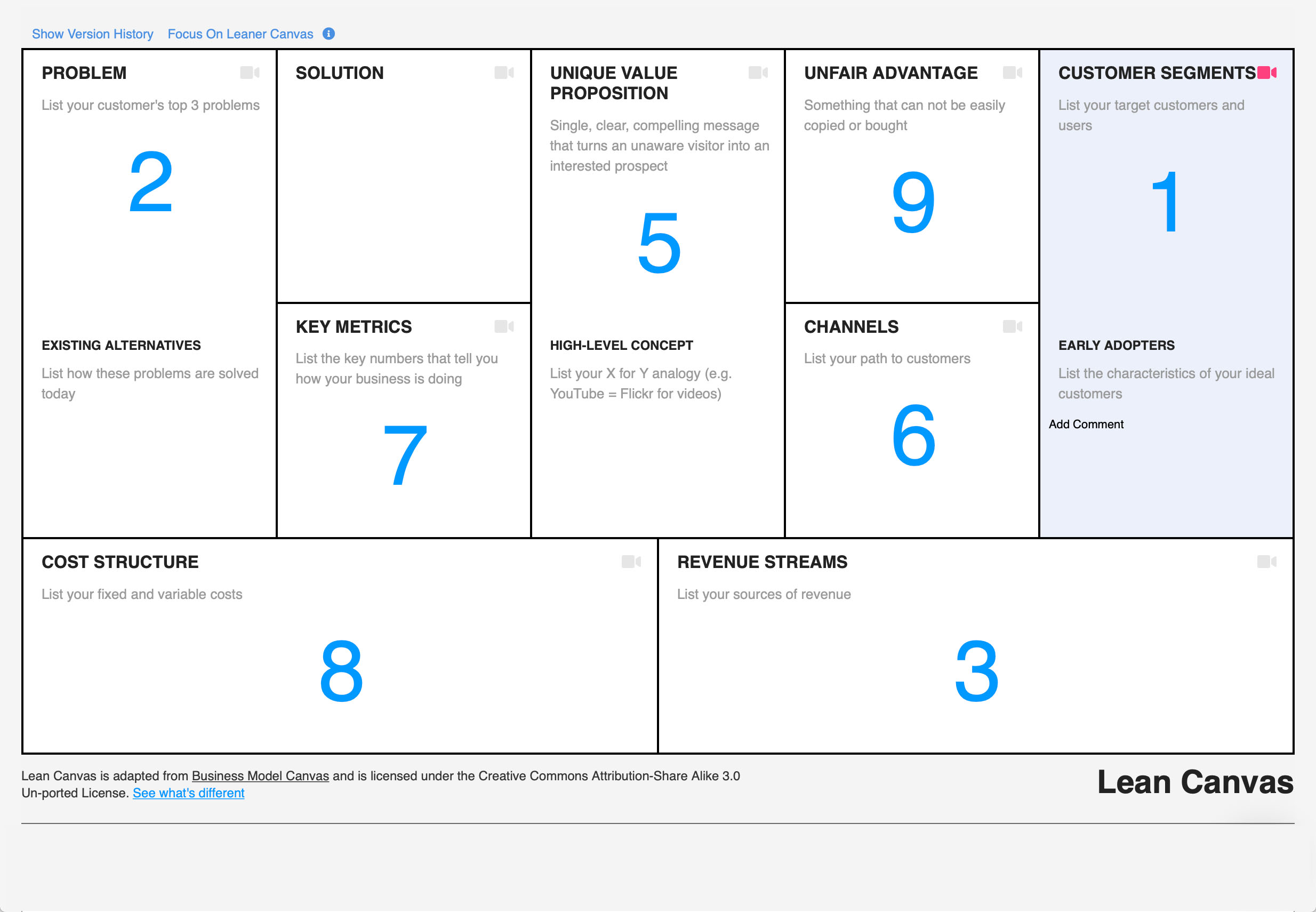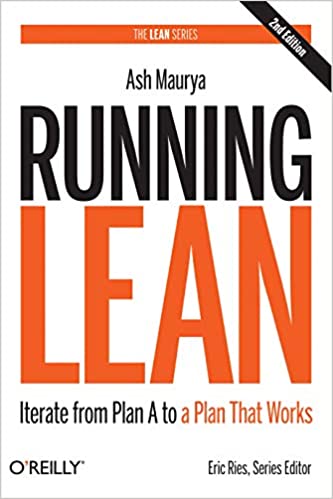
Running Lean Summary
How do you go about contacting your audience and establishing channels of communication? How many people do you contact? Exactly what do you say to ensure you’re collecting the right info (not just getting “feedback”)? Exactly what qualifies as a properly constructed MVP experiment? Precisely how do you do that? If it’s not answered in The Lean Startup, the remaining critical “how-to” questions are answered in this book: Running Lean by Ash Maurya.
If The Lean Startup is my bible, then Running Lean is my day to day operational manual. I use the outline below to look up and reread parts of the book as necessary. Hopefully you’ll find it as useful as I have.
Iterate from plan A to a plan that works.
Part 1: Roadmap
Meta-principles
Page 3. The author summarizes his book in three steps: document your plan A, identify the riskiest part of your plan, and systematically test your plan. He believes in capturing your hypothesis and in a 1 page canvas. He likes an adaptation of Alex Osterwalder’s Business Model Canvas. That adaptation is shown below in Part 2.
These are the three stages of a startup:
Stage 1: Problem/solution fit. Do I have a problem worth solving?
Stage 2: Product/market fit (PMF). Have I built something people want?
Stage 3: Scale. How do I accelerate growth?
Running lean illustrated
Page 15. The next example he talks about is how he used Running Lean principles in the creation of the book. He started by finding a solution, then validated qualitatively and verified quantitatively. To know how that works, see below.
Part 2: Document Your Plan A
Create your lean canvas
Page 23. Start by sketching out a Lean Canvas. You can get a copy of a Lean Canvas here. It’s OK to leave sections blank if you don’t have the right answers, but be concise and think in the present. Use a customer-centric approach to think about problems and customer segments. List the top three problems and some existing alternatives. List the user roles and think about who might be early adopters.

If you’re not familiar with Business Model Canvas, then this article which will help walk you through each of the canvas categories.
Unique Value Proposition (UVP)
“Instant clarity headline = end result customer wants + specific period of time + address the objections”
He uses Domino’s slogan as an example and I think it’s perfect. ‘Hot fresh pizza delivered to your door in 30 minutes or it’s free.’
High concept pitch
Can you explain your idea in a memorable sound bite? This is not a Unique Value Proposition and not to be used on your landing page, but is a good quick mental exercise. He cites Venture Hacks and its e-book (can ONLY be opened in Google Chrome) Pitching Hacks as the source of this exercise:
- Aliens: “Jaws in space”
- Dogster: “Friendster for Dogs”
Channels
As you’re looking at the category “channels,” it’s important to understand that “failing to build a significant path to customers is among the top reasons why startups fail.”
GRKKT: Y-Combinator has a lot more to say about this. If you don’t already know where your customers hang out, you may not have enough domain knowledge to launch a start up in that industry.
Right now, you’re not looking for press coverage. At this stage, outbound sales channels are hard to cost justify. You should be selling manually, before you try to automate. If you don’t know how to sell the product yourself, how are you going to train someone else to do it later?
Do things that don't scale.
- Paul Graham Tweet
Minimum Viable Product (MVP)
As you think about revenue streams and cost structure, think about what you will need define and build your Minimum Viable Product (MVP). I think it’s a critical point here he feels that an MVP should not be a “half baked or buggy product.” It absolutely has to solve a problem worth solving for your customers. It has to have enough value that you can actually charge money for it. That is a real Minimum Viable Product (MVP).
Price
Price is part of the product. It defines your customers. Getting paid is the most real form of validation there is.
Dave McClure’s Pirate Metrics for Startups: AARRR!
- Acquisition
- Activation
- Retention
- Revenue
- Referral
Unfair Advantage
Here he quotes Jason Cohen, from A Smart Bear blog, “A real unfair advantage is something that cannot be easily copied or bought.”
Unfair advantage examples include: Insider information. A degree of expertise (domain knowledge) unparalleled anywhere. Network affects. A community of existing customers. Special influencer connections that are unique to you.
GRKKT: For newbies, this is perhaps one of the most important and least understood parts of starting a startup. If you don’t have a definitive unfair advantage, Venture Capitalists (VCs) will be shy about providing funding. If your only advantage is that you are the first to have thought of the idea, you may be in trouble. It’s a major flag when founders want people to sign non-competes before they will even talk about the concept. VCs want to see something like patented tech, trade secrets or patented software algorithms you have developed that no one else has. Once you show a little traction, what’s keeping someone else from stealing your idea? “Fragile” is the word the startup world uses to label startups with ideas that are easily stolen or copied.
Part 3: Identify the Riskiest Parts of Your Plan
Prioritize where to start
Page 49. This answers the question “What startup should I start?” for a lot of people. Rank your Lean Canvas Models based on:
- customer pain level
- ease of reaching customers
- profitability
- market size
- technical feasibility
Seek external advice. This is where you might want to become familiar with The Mom Test. Or as Rob Fitzpatrick says on his website “How to talk to customers & learn if your business is a good idea when everyone is lying to you.”
Define your team
Page 57. Problem Team & Solution Team. Problem team is outside the building interviewing customers and collecting data on their problems. Solution team does development. Ideally a total of 2 or 3 people, this team covers the following roles:
- Development
- Design
- Marketing
Methodology:
- Maximize for speed, learning, and focus.
- Identify a single key metric or goal
- Do the smallest thing possible to learn.
- Create a hypothesis that is falsifiable
- Validate Qualitatively (interviews)
- Verify Quantitatively (surveys)
Stage One: Understand the Problem
GRKKT: Some inexperienced founders are so certain that their solutions are needed, customer interviews are not necessary. A clear sign of inexperience.
Get ready to interview customers
Page 71.
- DO NOT OUTSOURCE THESE CUSTOMER INTERVIEWS
- Do not use surveys or focus groups
- Interview 30-60 people
- Frame the interview around learning, not selling your idea
- Cast a wide net to avoid what is called “local-maxima”
- Start with your close friends and ask for introductions
- Always meet in person if possible
- Never ask what people want for a solution. Measure what they actually DO.
- Follow a script
The book provides some truly invaluable scripts and interview ideas not included in this summary. Following the right script will make a night and day difference in your results. If you don’t follow the scripts in the book, you may be wasting your time. The book also provides real world examples how these interviews worked for actual companies that went on to be successful. You might want to consider following their example.
Conduct problem interviews
Page 81.
- Ask them to rank their top 3 problems.
- How did they solve it?
- Why did that work or not work?
- Why is that a problem?, etc. (remember The Five Whys from The Lean Startup?)
You are done when you have (after interviewing at least 10 people):
- Identified a “must-have problem”
- Identified your early adopters
- Know what people are actually DOING now to solve this problem
Stage Two: Define Solution
Conduct solution interviews
Page 95. This is where you build a realistic demo / mockup of the product and test the solution. Now you are following solution interview scripts. Again, the book provides a great script to follow. If you don’t follow the scripts in the book, you may be wasting your time (yeah, the book is worth the price). You MUST ask about price in these interviews and the mockup must be real enough to fool a potential customer into thinking it’s real.
GRKKT: Google Ventures Sprint by Jake Knapp has some great examples of this.
You are done when you are confident that you:
- Identified a “must-have problem”
- Identified your early adopters
- Know what people are actually DOING now to solve this problem
- Know the minimum feature(s) the MVP needs to have to be able to charge for it
- Know how much you can charge for it
- Can build a business around it (at least with some quick math)
GRKKT: That last one I think is underrated. Viability is very much determined by development costs vs. potential revenue. What is that ratio? It’s not addressed in any book that I’ve found. As for MVP costs, I think most accelerators would agree that an MVP should be under $5K (or be free) and take less than a month to build +/-.
Get ready to release 1.0 of your product
Page 111. The smaller the scope of work for each iteration, the faster you can learn. Do the absolute minimum you have to do to have something to test from which you can learn. Shortening this cycle time is a key goal of businesses who follow Lean methodology. The goal is to end up deploying continuously.
At this point, Ash wants you to define your activation flow. How does the sign-up process work? Can you reduce sign-up fiction (reduced number of steps) but not at the expense of learning? Can you deliver on your unique value proposition? Provide a phone number or email if things go wrong.
Build a marketing website
Build a site that takes orders. This should be no more than a landing page. This is not a full website with SEO, blogs, etc. You are looking validate your Product Market Fit (PMF) with actual sales.
Stage Three: Validate Qualitatively
Get ready to measure
Page 121. Ash defines an actionable metric as “one that ties specific and repeatable actions to observed results.” He reminds you that in The Lean Startup the three A’s of metrics are “Actionable, Accessible and Auditable.”
You should be measuring acquisition, activation and revenue on a month-to-month and weekly basis. Comparing these weeks and months against each other is called comparing “cohorts.“ There are lots of good tools for tracking these things such as Google Analytics, Mixpanel and KISSmetrics.
The MVP interview
Page 127. The MVP interview much like the Problem and Solution interviews in that it is not about selling your product. It’s about learning. He advocates following the usability testing format outlined by Steve Krug in Rocket Surgery Made Easy. Running Lean provides a nice script to follow, too.
Validate customer lifecycle
Page 145. Here you want to make feedback easy because the easiest way and fastest way to learn from customers is actually talk to them. Your tech-support department should be in a continual learning loop of feedback. Tech-support is part of customer development and marketing. Troubleshoot your customer trials by drilling into your sub funnels. Reach out to your users to catch and report unexpected errors. Retention is arguably one of the most important metrics at this point. Send gentle email reminders and ask for customer testimonials. You have to get testimonials.
You are ready to launch the MVP when at least 80% of your early adopters make it through your conversion funnel.
Launch your MVP
Page 155. At this stage you should have an MVP, marketing website and a conversion dashboard ready for data analysis. You are now trying to get people to sign up, test your messaging, your pricing and your activation flow.
Are customers making it all the way through the activation flow? Are you affectively demonstrating your unique value proposition? Is the price right? Formulate testable hypotheses and conduct MVP interviews. It is particularly important to conduct these interviews in person if possible. It’s good to have your entire team present or at least viewing via remote screen. Or use recording software.
After you launch your MVP, your goal is to get enough traffic to support learning. He feels you can get usable data in as little as 5 users.
One of the things the book does that is invaluable, is it provides real world examples of what other companies have done to create and test their hypothesis. He provides MVP examples. Seeing these real-world examples really helps you get a grip on how to go about this process.
Stage Four: Verify Quantitatively
Don’t be a feature pusher
Page 145. This is the point where most founders fall into the trap of adding a ton of features based on requests from users (aka. the feature trap). This dilutes your unique value proposition. Give your MVP a chance. You should troubleshoot and resolve issues with existing features before adding new ones. Understand why people aren’t buying first. 80% of your focus should be on improving the existing features, not working on new ones.
Ash advocates using a Getting Things Done workflow, by David Allen.
His quick tips:
- Don’t split test new features because you can compare to older cohorts.
- Don’t split test experiments to get strong signals during qualitative testing.
- Split test experiments that get medium signals
- Split test improvements and alternate flows.
GRKKT: When it comes to understanding what features to add and when, I think Jobs To Be Done by Anthony W. Ulwick helps provide clarity. You can download a free PDF here.
The Sean Ellis Test (measure product market fit)
Page 155. The Sean Ellis Test is a survey with the key question, “How would you feel if you could no longer use this product?”
- Very disappointed
- Somewhat disappointed
- Not disappointed
If over 40% of your users are “very disappointed,” there’s a high probability you will have sustainable, scalable customer acquisition with a “must-have” product. If you cannot pass this test, you do not yet have Product Market Fit (PMF).
GRKKT: While it’s nice to talk about what product market fit measures like (or feels like) post hoc, it doesn’t do a lot to tell you how to get there if you’re not there. The best article I’ve ever seen on how to use customer interview data to get to PMF is this by Rahul Vohra, the founder and CEO of Superhuman.
Make something people want.
- Paul Graham Tweet
Conclusion
Page 169. In the conclusion, Ash provides a list of other recommended books, blogs and tools. He advises that getting funded always takes longer than you think and that you should keep your day job. Charge for your product from day one and create a daily flow for your work. He provides a little info on how to set pricing, build sales letters and how to build landing pages. Then he continues to provide real world examples of how others have done it. Hopefully by now you’ve realized that this book is indispensable. It will likely be at the very center of everything you learn and do (at least until you become the next Mark Zuckerberg).
For further info, you can access the original Lean Canvas and a lot of other planning tools here.
You can download an updated Lean Model Canvas here.

Running Lean: Iterate from Plan A to a Plan That Works (Lean Series) 2nd Edition
Author Bio
Benjamin Arritt

Share:
Follow Us:
Most Popular


10+ PERSONAL CRM OPTIONS REVIEWED

10 OUTSOURCED BDR SALES AGENCIES COMPARED

FRACTIONAL MARKETING: EFFICIENT BUSINESS GROWTH
Subscribe To Our Newsletter
No spam. Curated directories & articles about business, startups and templates.
MENU
Related Posts

How to Build a High-Performing Marketing Stack for CMO Success
Dive into our blog post to learn how chief marketing officers can transform from brand champions to revenue drivers and customer whisperers through a strategic

10+ PERSONAL CRM OPTIONS REVIEWED
Yes, there are “solutions,” but nothing is perfect. Here is the path of what I evaluated, what I liked, what I didn’t and why.

10 OUTSOURCED BDR SALES AGENCIES COMPARED
I interviewed several of the top performers according to Clutch, but this was not my exclusive source. Here’s why: some smaller companies, without as

FRACTIONAL MARKETING: EFFICIENT BUSINESS GROWTH
Fractional marketing involves hiring fractional marketers, or part-time marketing professionals. This way businesses can leverage specialized expertise while reducing the costs associated with a full-time
